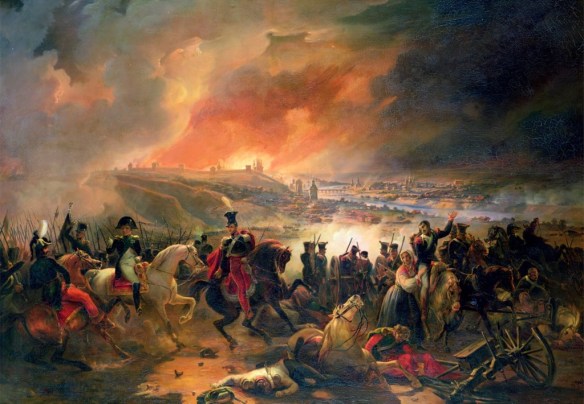The Russian city of Smolensk lies some 280 miles east of Moscow. The battle marked the first time that Napoleon faced a united Russian army; the encounter was indecisive for both sides, though Napoleon held the city.
When Napoleon planned his 1812 campaign against Russia, Smolensk was the farthest point that he expected to reach. He had hoped to force a decisive battle long before reaching that city, and had brought with him an enormous army of some half a million men. The very size of that army worked against it, however, as it was difficult to move quickly. Napoleon pursued the Russians and won numerous skirmishes, but the two Russian armies led by generals Mikhail Barclay de Tolly and Peter Bagration managed to elude him. Napoleon thought he had them trapped at Vilna in late June and then again a month later at Vitebsk. Each time, however, unnecessary delays on the part of the French, together with effective rearguard tactics by the Russians, allowed the Russians to withdraw toward Smolensk.
At both Vilna and Vitebsk, Napoleon delayed rather than pursued the withdrawing Russians. At Vilna he hoped to hear offers of peace from Tsar Alexander, but there was never any real chance of that happening. At Vitebsk his army was greatly reduced in fighting effectiveness due to the extremely hot weather it had endured. The Russian climate was already taking its toll in men and horses, and French supply lines were longer than ideal. Nevertheless, Napoleon decided to pursue the Russians, and they left Vitebsk for Smolensk on 13 August.
The French delay had allowed the two Russian armies to combine forces in Smolensk, presenting a force of some 50,000 men. Napoleon had spent much of 15 August, his birthday, idle, which allowed the Russians to prepare their defenses in Smolensk. On the sixteenth, the French and Russian armies clashed in the suburbs, each sustaining significant casualties. The city walls provided good defensive strength, and the French were unable to move forward with much success: The Russians had deployed their forces effectively. The French forces probed but did not attack in force. On the seventeenth, Napoleon sent three corps against the Russian defenses, but gained little for his effort. Russian casualties were as much as 14,000, but the French suffered losses nearly that high, an unfavorable circumstance for an invading army. The fighting had done great damage to the city, much of which was in flames during most of the day.
On the eighteenth, Bagration and Barclay de Tolly agreed to have the 2nd Western Army moved to the east to prevent a possible French flanking movement. Barclay de Tolly then had little choice but to begin his own withdrawal later in the day. Had the French pressed their attack on the eighteenth, they might have destroyed at least a large portion of the Russian army opposing them. Instead, the French were exposed to the sight of a burning city that surpassed even the spectacle of Moscow’s fires, not far in their future. By the nineteenth, the French were in control of the city, but Napoleon’s orders to block the retreating Russians were not effectively carried out by General Jean Junot. The Russians escaped with their army mostly intact.
During the battle, Napoleon had indicated that he would likely stay in Smolensk for the winter, which was in keeping with his original plans. The fires had not destroyed the entire city. Though his supply lines were even longer than they had been at Vitebsk, they were still not so long that they could not be maintained. He could organize the territory he had conquered, call for fresh troops and supplies, and renew the fight against the tsar in the spring. He could even simply declare victory, maintain the conquered territory, and leave the next step up to Alexander. He could recognize Poland as an independent nation, which would assure him of its loyalty and give him a new cadre of dedicated soldiers. Organizing this new Polish territory would take time, but the benefits were potentially very important. It was a good option, and one that Napoleon seriously considered.
Withdrawing to Vitebsk was another possibility. That city had troops and adequate provisions for the upcoming winter. Napoleon’s commanders and advisers were in favor of calling a halt to the campaign, and Napoleon gave strong consideration to the option of not moving forward, but he ultimately feared inaction more than the possibility of being lured further into Russia. He could have moved against the tsar at St. Petersburg, the capital, but when the Russian army retreated toward Moscow, Napoleon had little choice but to follow it. Within the week, Napoleon left Smolensk along the road to Borodino and Moscow.
Smolensk figured one more time in the 1812 campaign. When Napoleon decided to leave Moscow and was forced into a northern route, he hoped to return only as far as Smolensk. He had left a garrison in the city and presumed there would be adequate supplies to enable him to establish his winter quarters there. When he reentered that city, however, he discovered that the expected supplies did not exist, and the withdrawal from Russia, with all its terrible consequences, continued.
References and further reading Austin, Paul Britten. 1993. 1812: The March on Moscow. London: Greenhill. Chandler, David G. 1995. The Campaigns of Napoleon. London: Weidenfeld and Nicolson. Clausewitz, General Carl von. 1992. The Campaign of 1812 in Russia. London: Greenhill. Markham, J. David. 2003. Imperial Glory: The Bulletins of Napoleon’s Grande Armée 1805-1814. London: Greenhill. Nafziger, George F. 1988. Napoleon’s Invasion of Russia. Novato, CA: Presidio. Riehn, Richard K. 1991. 1812: Napoleon’s Russian Campaign. New York: Wiley. Zamoyski, Adam. 2004. 1812: Napoleon’s Fatal March on Moscow. London: HarperCollins.
